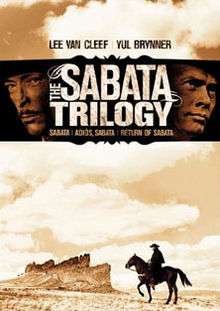The Sabata Trilogy
The Sabata Trilogy is a series of Spaghetti Western films released between 1969 and 1971, directed by Gianfranco Parolini, and starring Lee Van Cleef in the first, Sabata, Yul Brynner in the second, Adiós, Sabata, and Van Cleef returning for the third, Return of Sabata.
| The Sabata Trilogy | |
|---|---|
 The DVD trilogy cover. | |
| Directed by | Gianfranco Parolini |
| Produced by | Alberto Grimaldi |
| Written by | Renato Izzo Gianfranco Parolini |
| Starring | Lee Van Cleef Yul Brynner |
| Music by | Marcello Giombini Bruno Nicolai |
| Cinematography | Sandro Mancori |
| Distributed by | United Artists |
Release date |
|
Running time | 315 minutes |
| Country | Italy |
| Language | Italian |
Sabata
Lee Van Cleef stars as a mostly silent, loner gunman who foils a plan by some leaders of a small Texas town to rob their own bank and sell the town to the railroad.[1] William Berger co-stars as Banjo, an opposing gunman.[2]
Adiós, Sabata
With Yul Brynner cast in the lead role, this film was originally going to be entitled Indio Black, but the title was changed after the first Sabata film proved successful and had inspired many imitators. Lee Van Cleef, star of the first Sabata film, had been offered the role, but had to decline because he was committed to The Magnificent Seven Ride in the role of Chris Adams, which Brynner had made famous in The Magnificent Seven. Adiós, Sabata is set in Mexico under the rule of Emperor Maximilian I, and Sabata is hired to steal a wagonload of gold from the Austrian army.
Return of Sabata
Lee Van Cleef returns to the role of Sabata, who goes to a small Texas town and seeks revenge on a robber baron, determined to steal back some money that the man has stolen from the towns people.[3]
Other Sabata films
As was common with successful Spaghetti Western franchises, such as the Dollars Trilogy, Django or Sartana series', several other Sabata imitators were released. None of these are considered part of the "official" series. They include:
- Wanted Sabata (1970) directed by Roberto Mauri and starring Brad Harris.
- Arriva Sabata! (1970) directed by Tulio Demicheli and starring Peter Lee Lawrence.[4]
- Dig Your Grave Friend... Sabata's Coming (1971) directed by Juan Bosch and starring Raf Baldassarre.[5]
- Watch Out Gringo! Sabata Will Return (1972) directed by Alfonso Balcázar and Pedro Luis Ramírez, and starring George Martin.[6]
References
- Hughes, Howard (31 March 2006). Once Upon A Time in the Italian West: The Filmgoers' Guide to Spaghetti Westerns. I.B.Tauris. p. 216. ISBN 9780857730459.
- Weldon, Michael (1996). "The Psychotronic Video Guide". Titan Books: 478. ISBN 9781852867706. Cite journal requires
|journal=(help) - Hughes, Howard (30 April 2011). Cinema Italiano: The Complete Guide from Classics to Cult. Bloomsbury Publishing. p. 160. ISBN 9780857719782.
- Núñez Marqués, Anselmo (2006). Western a la europea--: un plato que se sirve frío. Entrelineas Editores. p. 274. ISBN 9788498024326.
- Prickette, James (20 January 2012). McLendon, Charles Anthony (ed.). Actors of the Spaghetti Westerns. Xlibris Corporation. p. 214. ISBN 9781469144290.
- Weisser, Thomas (22 August 2005). Spaghetti Westerns--the Good, the Bad and the Violent: A Comprehensive, Illustrated Filmography of 558 Eurowesterns and Their Personnel, 1961-1977. McFarland Publishing. p. 349. ISBN 9780786424429.